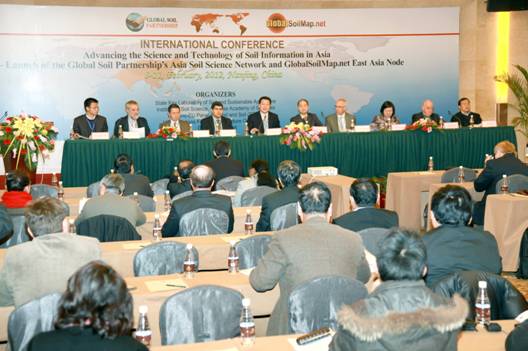From February 8 to February 11, 2012, the International Conference “Advancing the Science and Technology of Soil Information in Asia -Launch of the Global Soil Partnership’s Asia Soil Science Network and GlobalSoilMap.net East Asia Node ” jointly sponsored by the Institute of Soil Science of Chinese Academy of Sciences, Food and Agriculture Organization of the United Nations (FAO) and GlobalSoilMap.net was successfully held in Nanjing. The meeting was organized by the Institute of Soil Science of Chinese Academy of Sciences and the State Key Laboratory of Soil and Sustainable Agriculture. The meeting has been funded by the FAO, the Chinese Academy of Sciences, National Natural Science Foundation of China and the Ministry of Science and Technology. This meeting was attended by more than 80 representatives from Japan, Korea, Thailand, Malaysia, Mongolia, Indonesia, Vietnam, the Philippines, Bangladesh, Sri Lanka, Cambodia, Pakistan, Bhutan, Nepal, China as well as Australia, United Kingdom, Germany, Austria, Italy, Spain, the Netherlands, Hungary, etc.
This conference was targeted at promoting the development of the Asian soil information science and technology. Based on this theme, the representatives exchanged ideas and discussed about issues such as the status quo and problems of the soil information in East Asia, new theoretical and technological research progress of the soil information science, breakthroughs and prospects of the digital soil mapping methods in obtaining the high-precision digital soil information, digital soil information and global resources and environmental problems, and scientific and technological cooperation on soil resources information in East Asia. Meanwhile, scientists from the six EU countries and Australia respectively gave a report and put forward many valuable comments on the status quo of the field and the cutting-edge scientific issues. Through the joint efforts of the representatives, the “Asian Soil Partnership Program Nanjing Communiqué” was drafted and signed in the meeting on February 11. Many consensuses were reached and the following four points were regarded as something to be given priority to: 1. to share and transfer soil knowledge and new technologies inside and outside the region; 2. to provide soil information related to the sustainable use of soil and land resources for each interested party; 3. to establish the standard and constantly updated Asian soil information system and support the construction of the global soil information system such as the " GlobalSoilMap.net”; 4. to train a new generation of experts in the soil science and land management fields. To achieve the above objectives, the participants agreed to establish the “Asian Soil Partnership Program", while the secretariat would be located in the Institute of Soil Science of Chinese Academy of Sciences.
The Institute of Soil Science of Chinese Academy of Sciences participated in the initiation of the “GlobalSoilMap.net” in 2009 and became the East Asian regional center of the program, leading and coordinating the related research work in East Asia and constituting the global network together with centers in North America, South America, Europe, Africa and Oceania. In 2011, FAO proposed the Global Soil Partnership Program, and the Institute of Soil Science of Chinese Academy of Sciences was elected as the regional center in Asia. The convening of the meeting and the formulation of relevant resolutions symbolize the central position of the Institute of Soil Science of Chinese Academy of Sciences in the above two global programs, which is of great significance in fully playing its leading and coordinating role as the regional center, strengthening regional and global cooperation and further enhancing China’s academic status and international influence in the soil information scientific field.
 |
| A scene of the International Conference |
